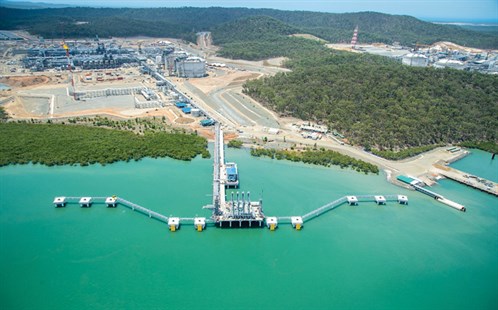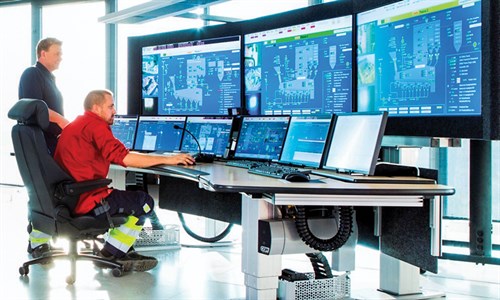LNG looks to digitalization to ease the pressure of a tight fiscal market
Natural gas, as the cleanest-burning hydrocarbon and in its abundance, is a significant part of the future energy mix. Between now and 2035, natural gas demand is expected to grow at an average of 2%/yr, twice the rate of total global energy. According to Royal Dutch Shell’s “LNG outlook 2018,”1 strong demand for cleaner-burning fuel in Asia continued to drive rapid growth in LNG use in 2018, with global demand rising by 27 metric MMt to 319 metric MMt. Shell expects demand to reach approximately 384 metric MMt in 2020.
To meet this demand, more than 120 large LNG facilities are at various stages of planning. To secure commitment to build or take a final investment decision (FID) on these projects, they must be cost-competitive in a market where gas is readily abundant, especially in North America; yet, the sales price of gas is extremely low. In fact, it is the lowest price seen since the early 1980s. This squeezing of margins is further driven by the globalization of LNG markets—with a growing proportion of output traded on the spot market rather than sold on long-term, oil-linked contracts.
Matching the market dynamics. In a situation where abundant feedstock is available, operators must find a way to move this product to a market that is willing to pay for it—e.g., Europe, Southeast Asia, China and Japan.
Many LNG projects are in harsh or remote locations, which makes them more challenging and expensive to develop and operate. Historically, LNG facilities have been designed and operated with a strong focus on achieving high production rates, even at the expense of high operating costs, but market forces are demanding a change in that focus. Many projects are striving to be the most competitive.
The role of the supply chain is to help optimize the overall solution and the project execution so that the most cost-competitive project can secure the funding to get to market.
The importance of a robust digital strategy. Numerous advantages can be gained from developing such a strategy, but chief among them are improvements to cost, safety, schedules and efficiency.
Cost is the key driver, and operators are looking for technologies to help reduce costs and enhance efficiency. One method is via simulation. The benefits of the simulator extend well beyond operator training. Using simulation much earlier in the project lifecycle, to test and verify application software in a virtualized engineering environment, can have multiple benefits.
LNG facilities typically generate and utilize significant amounts of electrical power and, therefore, present a perfect opportunity for end users to capitalize on the benefits of fully integrated process, safety and power automation solutions.
To fully extract the benefit of integrated process, safety and power automation solutions, a digital twin can be extended to include electrical generation and distribution system simulation alongside the process simulation. This extended simulation provides a replica, or digital twin, of the plant’s process and the electrical generation and distribution system. This creates a more accurate real-world environment to expose operators to situations and circumstances they may never experience during day-to-day operations.
Simulation in the operational phase can also help companies ensure compliance with regulatory testing, optimize electrical consumption and lower electricity costs. It can even be used to verify and validate new control strategies, equipment, procedures and sequences, or to investigate optimization and energy-saving opportunities.
As part of a robust energy management solution, a companya worked with an onshore EPC contractor to integrate and manage the existing electrical system at Tangguh’s LNG trains in Indonesia. The customer required support to prepare the factory acceptance test (FAT) environment, including the tuning of control application generator interfaces to shorten commissioning time and expenses for load tests. Operator training was also required before and after go-live.
Six generators, 25 transfers and 80 loads were simulated to track the results and impact of each operation performed, thereby minimizing any unexpected equipment behavior by integrating the power simulatorb with the extended automation system.c The result was an increased availability of 30%, reduced pre-engineering time and reduced costs for the generator load test.
With this simulation tool, the system can be designed optimally upfront to reduce both the operational costs and startup costs of a plant, which can be more economical and sustainable.
Enhancing efficiency. In this age of energy transition, energy management will also play a bigger role. LNG plants, which are high users of power, will need to consume less energy and produce less emissions.
LNG facilities use much electrical power, as well as utilize various process packages. To minimize costs (both CAPEX and OPEX) requires an automation platform that is open to third-party system integration and is part of a wider solution that can fully integrate the electrical elements of the system.
With the extended automation system,c it is possible to substantially lower the capital cost, as well as improve maintenance operations, because only one engineering environment must be learned. Only one system must be kept secure from a cybersecurity point of view, and only one interface exists to the historian and manufacturing execution system.
In practice, the companya worked alongside Queensland Curtis LNG (Fig. 1), a wholly owned subsidiary of BG Group, to deliver an integrated control, electrical, safety and telecommunications systems at its upstream and midstream facilities. The project, located in Australia, is the world’s first to convert coal seam gas into LNG. Its facilities stretch across the Surat basin, where the coal seam gas is gathered and transported along a 540-km underground pipeline to the LNG plant on Curtis Island near Gladstone.
 |
|
Fig. 1. Queensland Curtis LNG, the first plant to produce LNG from coal seam gas, has an integrated control, electrical, safety and telecommunications systems at its upstream and midstream facilities. |
As the main automation contractor for the project, the companya provides comprehensive services, including an onsite team to maintain the extended automation distributed control systemc (DCS) in place. The DCS for process control has been integrated with other plant and remote pipeline systems, as well as safety, compressor protection, emergency shutdown, fire and gas applications and other related automation equipment and services (Fig. 2).
 |
| Fig. 2. The DCS for process control at Queensland Curtis LNG has been integrated with other plant and remote pipeline systems, as well as several other equipment and services. |
Additions included a fiber-optic telecommunication systems infrastructure; CCTV incorporating a perimeter intrusion detection system and a security access control system; and installed electrical supply systems, including the supply of low-voltage and medium-voltage switchgears, compressor stations, transformers and a power management system.
This integration gives total visibility of the entire system for operations, maintenance and asset and alarm management, providing a large amount of live, real-time and diagnostic data on assets and production. As a result, business managers are able to make more accurate decisions based on information across the whole plant.
As a direct result, Queensland Curtis LNG has reported an increase in safety and efficiency of the upstream gas gathering and compression facilities. Additionally, it has been able to provide open communications to remote operations throughout the 540-km pipeline network.
Maintaining a schedule. When the plant gets the green light, it is crucial that the timelines are adhered to; automation has a role here, as well.
LNG facilities typically have numerous process packages that require many interfaces to bring the information into the automation solution. Tools have been developed to manage those interfaces. If interface management is pulled into the scope of supply, then project costs can be reduced.
New solutions can consume engineering data from the EPC contractors and auto-generate a large amount of the application software, which reduces the human error in the process. This has a positive effect in reducing the amount of testing time needed. Working with EPCs has yielded a 25% reduction in the planning and design phase, a 20% reduction in the overall build and integration phase, and a 30% savings during the maintenance and operations phase. A fully integrated process control, safety and power system solution requires less hours onsite.
Utilizing a configurable 800xA select IO system has allowed for decoupling of hardware and software engineering. In traditional projects, the software and hardware engineering are not separated, which creates an ongoing loop with updates to both the software and hardware. Now, the two tasks can be split and run completely independently and in parallel. They can be brought together much later in the project lifecycle, and engineering tools can be used to auto-generate much of the application software to enable a late start and an early finish. A fully integrated system solution means less interfaces and, therefore, less hours to commission it onsite. It also reduces the overall project schedule.
An initial front-end engineering and design (FEED) study was first completed for Queensland Curtis LNG, followed by robust and holistic interface management of all engineering suppliers. This helped deliver a coherent and standardized approach, thereby harmonizing project execution, taking responsibility for data transfer between parties, driving efficiency, reducing risk, generating cost savings and securing a reduction in FEED cycle time.
Improving safety. Several digital applications can assist end users in meeting regulatory compliance in terms of functional safety management. One applicationd allows data to be captured in the risk assessment phase and pushed through into the design phase, the build phase, and then into the sustain and operate phase. It is a total lifecycle approach, designed to assist projects over those four major project lifecycles, where captured data can be used by operators with risk assessment via automated reporting and testing regimes.
This type of approach is also being applied to alarm management, where smart devices are deployed and allowed to connect and move the diagnostic data into the cloud. Tools are also available to mine that data for cybersecurity threats.
AI and machine learning. Many other digitalization tools can be deployed, such as artificial intelligence (AI), machine learning and data analytics. The sector at large is just starting that journey, and now these technologies are generally being deployed to optimize smaller pockets of an entire LNG plant, such as in the maintenance or process aspects.
Despite this, these technologies are making impacts in areas such as motors, rotating equipment and compressors, all of which are critical components to an LNG facility. Here, machine learning and predictive analytics are being applied to monitor critical assets so that operators can know weeks or months before the equipment will fail. In the future, the industry wants to have greater visibility over the entire process, using digital twins to optimize the entire solution.
From a digital perspective, the next steps are to start utilizing machine learning, artificial intelligence and big data analytics to reduce the amount of energy consumed, while simultaneously reducing emissions. The next step will be increasing electrification across operations with an all-electric LNG plant.
Electrification in the floating LNG market. Ensuring a coherent and standardized approach to electrification and power for topside production facilities on floating production, storage and offloading LNG vessels is another area to consider.
The company,a which worked on Petronas’ FLNG2 vessel, was given the job of designing, manufacturing and installing the electrical systems for one of the world’s first commercial floating LNG (FLNG) platforms. The platform is Petronas’ second LNG facility. When it is completed in 2020, it will be stationed over the Rotan gas field offshore Malaysia.
The design of the electrical systems, which included transformers, switchboards, motor-control centers and a power management system, was challenging for several reasons. The process of liquefying natural gas requires high pressures and high electrical loads produced by machinery that must be accommodated within a tightly restricted area. This area is shared by both the operators and the crew and contains highly flammable gases, all of which are subject to the usual hazards of life at sea.
The companya was also awarded the electrical contract for Golar’s second FLNG vessel conversion project, as part of the first phase of BP’s Greater Tortue Ahmeyim LNG development in West Africa. The companya is providing a power system study, medium- and low-voltage switchgears, and transformers to cater to the power needs on both the hull and topside of the 1978-built Moss LNG carrier Gimi, located nearshore on the maritime border of Mauritania and Senegal.
Treading the path. Energy companies have embraced digitalization over the past few years as an effective means of reducing costs and raising efficiencies under increasingly challenging business conditions. These efforts are already delivering impressive results. An increase is seen in enabling technologies and renewed organizational models.
Discussions are taking place with energy companies about introducing a new discipline of a digital lead into FEED teams, to ensure that all digital opportunities are capitalized on during plant design. Most recently, this approach was taken on NextDecade’s Rio Grande LNG project.
More end users are seeking to develop this integration into the overall solution upfront and as early as possible, so that they can greatly reduce EPC hours and optimize opportunities for cost saving during the operational phase. It is a transition, but the advantages that digitalization offers throughout the lifecycle of an LNG project make it imperative into the future. GP
Notes
a ABB
b ABB Process Power Simulator
c ABB Ability System 800xA Simulator
d ABB SafetyInsight
Literature cited
- Royal Dutch Shell, “Shell LNG outlook 2018,” 2018, online: https://www.shell.com/energy-and-innovation/natural-gas/liquefied-natural-gas-lng/lng-outlook-2018.html
 |
Nathan Tungseth is Senior Vice President and Global Segment Manager for Onshore Oil and Gas at ABB Energy Industries in London. He has worked with ABB for 13 yr, having spent the past 9 yr developing and managing teams to execute major oil and gas projects both in the U.S. and internationally. Prior to ABB, he worked at Siemens Power Generation for 4 yr. A U.S. native, Mr. Tungseth graduated from the University of Central Florida, where he earned a BS degree in mechanical engineering. He also studied at Jonkoping University in Sweden, with a focus in foundry technology; and at Rice University in Texas, where he earned a graduate certificate in finance and accounting.




Comments